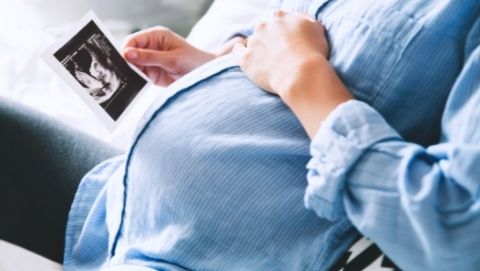Pregnancy and Substance Use

The use of alcohol and other harmful substances, such as cocaine, opioids, and marijuana during pregnancy has increased over the last decades (Sebastiani et al., 2018). Using these substances can be very harmful to the unborn baby and mother (Viteri et al., 2015). This fact sheet will cover (1) the consequences of substance use and (2) the current recommendations for substance use during pregnancy.
General Consequences of Substance Use
One reason using alcohol, tobacco, illicit drugs, or misusing prescription medication can be so harmful during pregnancy is because many of these substances can easily pass through the placenta and to the fetus (Jones & Fielder, 2015; NIDA, 2020a).
Regular maternal use of some drugs during pregnancy may cause neonatal abstinence syndrome (NAS). NAS is where the infant goes through withdrawal at birth (National Institute on Drug Abuse [NIDA], 2020a). Research has shown opioids (such as heroin or prescription pain relievers), alcohol, barbiturates, caffeine, and benzodiazepines cause an infant to experience withdrawal symptoms at birth. The type and severity of the withdrawal symptoms in an infant depend on the substance(s), length, and frequency of use, and whether the infant was born prematurely or full-term (NIDA, 2020a).
Research has also found an association between substance use during pregnancy and an increased risk of miscarriage, stillbirth, congenital disabilities, premature birth, low birth weight, sudden infant death syndrome (SIDS), and adverse long-term effects in the child (Lind et al., 2017; Viteri et al., 2015).
Seeking treatment and professional help as soon as possible for substance use may help reduce the health risks for both mother and fetus. Figure 1 may help you to evaluate if a possible substance abuse disorder exists.
Nutritional Impact of Substance Use
Nutrition and the mother’s diet are very important during pregnancy, helping the fetus grow and develop properly. However, substance dependency can affect how certain nutrients are absorbed in the body and result in poor growth and development. For example, excessive amounts of alcohol can interfere with the absorption of some essential amino acids, vitamin A, vitamin C, various B vitamins, and folate. All these nutrients are essential to the growing fetus (Sebastiani et al., 2018). For example, folate deficiency increases the risk of neural tube defects in infants (Sebastiani et al., 2018). Many harmful substances also decrease appetite in the user, which during pregnancy may not allow for needed energy and nutrients to get to the fetus (Sebastiani et al., 2018).
Talk with your doctor or medical provider to discuss the impact of substance use on nutrition during pregnancy. Improving maternal diet during pregnancy may help to improve the infant’s long-term health outcomes.
Figure 1.
Self Evaluation of Possible Substance Abuse Disorder
| Have you ever felt that you ought to cut down on your drinking or drug use? |
| Have people annoyed you by criticizing your drinking or drug use? |
| Have you ever felt bad or guilty about your drinking or drug use? |
| Have you ever had a drink or used drugs first thing in the morning to steady your nerves or to get rid of a hangover (eye-opener)? |
| Scoring: One or more “yes” responses indicate a possible substance use disorder and the need for further testing. |
Note: Information was adapted from Brown & Rounds, 1995 and Hinkin et al., 2001.
Sudden Withdrawal Consequences
Pregnancy brings about many physical changes in the mother, alters her body’s metabolism, and may alter withdrawal rates. The intensity and length of withdrawal may depend on how long the substance use has occurred, the amount of substance consumed, the type, and the intake method (Figure 2). Genetics may also influence the withdrawal rate (Editorial Staff, 2021).
Physical dependence often accompanies substance use. This means if the substance use stops suddenly, serious, and possibly life-threatening, withdrawal symptoms may occur, possibly putting the fetus may be put at risk (Steele et al., 2020). If opioid-dependent, the American College of Obstetricians and Gynecologists warns that preterm labor, fetal distress, and even fetal death may occur if mothers stop substances suddenly. Due to these possible consequences, it is not recommended, even when pregnant, that individuals struggling with substance dependence stop "cold turkey" without professional guidance and help (Steele et al., 2020; Editorial Staff, 2021).
Figure 2.
General Timeline for Maternal Withdrawal Symptoms
• Opioids: 12-72 hours
• Benzodiazepines: 1-12 days
• Barbiturates: 4-10
Note: Estimations were provided by the New York State Office of Alcoholism and Substance Abuse Services.

Medical Detox
There are evidence-based treatments for pregnant women with substance use disorders that may have great benefits. Proper prenatal care and participating in a comprehensive drug treatment program have been associated with improving many of the consequences of substance use during pregnancy (NIDA, 2020b).
A process called medical detoxification is generally recommended as the safest for women as they strive to stop taking harmful substances during pregnancy. Medical detoxification is medically supervised and done in a safe environment. If necessary, medications may be given to help with the detoxification process and relieve symptoms. While there are no FDA-approved medications to help treat substance dependence, NIDA reports that there are some low-risk replacement medications that may be beneficial during detox (2020b).
Medication for Opioid Use Disorder
For pregnant women with an opioid use disorder (OUD), the generally recommended therapy is opioid agonist pharmacotherapy (Committee on Obstetric Practice, 2017). This therapy involves taking medications that may help relieve symptoms of substance dependence (Global Health Observatory, n.d.). Opioid agonist pharmacotherapy is often preferable to medically supervised withdrawal as withdrawal may be associated with high relapse rates, leading to worse outcomes. More research is needed to assess the safety and long-term outcomes of medically supervised withdrawal (Committee on Obstetric Practice, 2017).
Two common medications used to treat opioid dependence are methadone and buprenorphine. Both medications are long-acting opioid drugs used to replace opioids like heroin or prescription painkillers. While these medications still carry the risk of an infant developing withdrawal symptoms, the infants typically have fewer and less severe symptoms of withdrawal (Editorial Staff, 2021). These medications can only be prescribed by trained doctors who hold the proper certification.
(Berg et al., 2008)

Medication for Alcohol Dependency During Pregnancy
We currently have limited data on treating pregnant women who misuse alcohol and are alcohol-dependent. Benzodiazepines are most often prescribed to manage alcohol withdrawal symptoms. The research also suggests psychosocial interventions, along with benzodiazepines, have great success in reducing consumption and maintaining sobriety (Heberlein et al., 2012). While there is minimal preliminary data, support of naltrexone may also help treat alcohol dependency among pregnant women (Heberlein et al., 2012). It is vital to work closely with medical professionals to understand the risks associated with the withdrawal symptoms and the risks associated with the medications that may help those withdrawal symptoms.
Conclusion
Substance or alcohol use during pregnancy may be very harmful to both mother and infant. Consult with a healthcare provider before starting or stopping medications, especially during pregnancy. A healthcare provider can explain the risks and benefits of detox or medication therapy and provide support and guidance through that process.
Additional Resources
Substance or alcohol use during pregnancy may be very harmful to both mother and infant. Consult with a healthcare provider before starting or stopping medications, especially during pregnancy. A healthcare provider can explain the risks and benefits of detox or medication therapy and provide support and guidance through that process.
- Substance Use in Women Research Report
- Principles of Drug Addiction Treatment: A Research-Based Guide (Third Edition)
- American Addiction Centers, Recovery First Treatment Center
- Substance Abuse and Mental Health Services Administration (SAMHSA), Frequently Asked Questions.
- Academy of Perinatal Harm Reduction
- 1-800-662-HELP (4357). The Substance Abuse and Mental Health Services Administration National Helpline provides treatment referral and information 24/7. It is free, confidential, and available in English and Spanish.
Authors
Elise Withers, B.S.; Krista Thompson, B.S.; Emily Hamilton, B.S.; Maren Wright Voss, Ph.D., Sc.D.; Maren Wright Voss, Sc.D.
References
- Berg, R. C., Winsvold, A., Kornør, H., Øverland, S., Smedslund, G., Hammerstrøm, K. T., Storetvedt, K., Johnsen, J., Hansen, H., & Tømmervik, K. (2008). Effects of opioid agonist treatment for pregnant opioid dependent women. Knowledge Centre for the Health Services at The Norwegian Institute of Public Health (NIPH).
- Brown, R., & Rounds, L. (1995). Conjoint screening questionnaires for alcohol and other drug abuse: Criterion validity in a primary care practice. Wisconsin Medical Journal, 94,135–40.
- Committee on Obstetric Practice. (2017). Opioid use and opioid use disorder in pregnancy. The American College of Obstetricians and Gynecologists. https://www.acog.org/clinical/clinical-guidance/committee-opinion/articles/2017/08/opioid-use-and-opioid-use-disorder-in-pregnancy
- Editorial Staff. (2021). What are the addiction treatment options for pregnant woman? Recovery First Treatment Center. https://recoveryfirst.org/drug-abuse/treatment-for-pregnant-woman/
- Frazer, Z., McConnell, K., & Jansson, L. M. (2019). Treatment for substance use disorders in pregnant women: Motivators and barriers. Drug and Alcohol Dependence, 205, 107652. doi:10.1016/j.drugalcdep.2019.107652
- Global Health Observatory. (n.d.). Opioid agonist pharmacotherapy used for the treatment of opioid dependence. World Health Organization. https://www.who.int/data/gho/indicator-metadata-registry/imr-details/2718.
- Heberlein, A., Leggio, L., Stichtenoth, D., & Hillemacher, T. (2012). The treatment of alcohol and opioid dependence in pregnant women. Current Opinion in Psychiatry, 25(6), 559–564. doi:10.1097/YCO.0b013e328358ad36
- Hinkin, C., Castellon, S., Dickson-Fuhrman, E., Daum, G., Jaffe, J., Jarvik, L. (2001). Screening for drug and alcohol abuse among older adults using a modified verson of the CAGE. American Journal of Addiction 10, 319–26.
- Jones, H. E., & Fielder, A. (2015). Neonatal abstinence syndrome: Historical perspective, current focus, future directions. Preventive Medicine, 80, 12–17. https://doi.org/10.1016/j.ypmed.2015.07.017
- Lind, J. N., Interrante, J. D., Ailes, E. C., Gilboa, S. M., Khan, S., Frey, M. T., Dawson, A. L., Honein, M. A., Dowling, N. F., Razzaghi, H., Creanga, A. A., & Broussard, C. S. (2017). Maternal use of opioids during pregnancy and congenital malformations: A systematic review. Pediatrics, 139(6). doi:10.1542/peds.2016-4131
- National Institute on Drug Abuse. (2020a). Substance use while pregnant and breastfeeding. https://www.drugabuse.gov/publications/research-reports/substance-use-in-women/substance-use-while-pregnant-breastfeeding
- National Institute on Drug Abuse. (2020b). What are the unique needs of pregnant women with substance use disorders? https://www.drugabuse.gov/publications/principles-drug-addiction-treatment-research-based-guide-third-edition/frequently-asked-questions/what-are-unique-needs-pregnant-women-substance-use
- Sebastiani, G., Borrás-Novell, C., Casanova, M. A., Pascual Tutusaus, M., Ferrero Martínez, S., Gómez Roig, M. D., & García-Algar, O. (2018). The effects of alcohol and drugs of abuse on maternal nutritional profile during pregnancy. Nutrients, 10(8), 1008. doi10.3390/nu10081008
- Steele, S., Osorio, R., & Page, L. M. (2020). Substance misuse in pregnancy. Obstetrics, Gynaecology & Reproductive Medicine, 30(11), 347–355. https://doi.org/10.1016/j.ogrm.2020.09.002.
- Viteri, O. A., Soto, E. E., Bahado-Singh, R. O., Christensen, C. W., Chauhan, S. P., & Sibai, B. M. (2015). Fetal anomalies and long-term effects associated with substance abuse in pregnancy: A literature review. American Journal of Perinatology, 32(5), 405–416. doi10.1055/s-0034-1393932
Related Research






